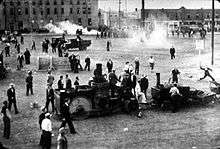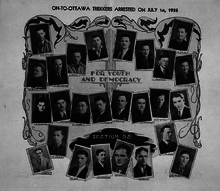On-to-Ottawa Trek

The On-to-Ottawa Trek was a long journey where thousands of unemployed men protested the dismal conditions in federal relief camps scattered in remote areas across Western Canada. The men lived and worked in these camps at a rate of twenty cents per day before walking out on strike in April 1935. After a two-month protest in Vancouver, British Columbia, camp strikers voted to bring their grievances to the federal government. The Great Depression crippled the Canadian economy and left one in nine citizens on relief.[1] The relief, however, did not come free; the Bennett Government ordered the Department of National Defence to organize work camps where single unemployed men were used to construct roads and other public works at a rate of twenty cents per day. The poor working and living conditions led to general unrest in the camps.
The Workers' Unity League helped the men organize the Relief Camp Workers' Union in 1933. A strike was held in December 1934 with the men leaving the various camps and protesting in Vancouver. They returned to the camps after a promise of a government commission to look into their complaints. When a commission was not appointed a second strike was approved by the members and a walkout was called on April 4, 1935.
About 1,600 strikers headed for Ottawa.[2] The strikers’ demands were wages of 50 cents an hour for unskilled work, union wages for skilled, and at least 120 hours of work a month; the provision of adequate first aid equipment in the camps; the extension of the Workmen’s Compensation Act to include camp workers; recognition of democratically elected workers' committees; that workers in camps be granted the right to vote in elections; and the camps be removed from the prevue of the Department of National Defence. Public support for the men was enormous but the municipal, provincial and federal governments passed responsibility between themselves. They then decided to take their grievances to the federal government. On June 3, 1935, hundreds of men began boarding boxcars headed east in what would become known as the “On-to-Ottawa Trek.”
Meeting in Ottawa
The protesters reached Regina, Saskatchewan, on June 14 and met with two federal cabinet ministers in the government of Prime Minister R. B. Bennett on June 17. Robert Manion and Robert Weir invited eight elected representatives of the protest (including Arthur "Slim" Evans) to Ottawa to meet Bennett on the condition the rest of the protesters stay in Regina, where a large contingent of the Royal Canadian Mounted Police was located. The remaining trekkers continued to stay in the stadium located on Regina Exhibition Grounds, eating meals in local restaurants.
The June 22nd Ottawa meeting turned into a shouting match, with Bennett attacking the group as radicals and accusing Trek leader Arthur "Slim" Evans of being an "embezzler." Evans in turn called the Prime Minister "a liar" before the delegation was escorted out of the building and on to the street.
Regina Riot

The eight delegates arrived back in Regina on June 26. Attempts of the Trekkers to travel east by car or truck or train were thwarted by RCMP. A public meeting was called for July 1, 1935, in Market Square in Germantown (now the site of the Regina City Police station) to update the public on the progress of the movement. It was attended by 1,500 to 2,000 people, of whom only 300 were Trekkers. Most Trekkers decided to stay at the exhibition grounds.
Three large moving trucks were parked on three sides of the square concealing RCMP riot squads. Regina police were in the garage of the police station which was in Market Square. At 8:17 p.m. a whistle was blown and the police charged the crowd with batons from all four sides. The attack caught the people off guard before their anger took over. They fought back with sticks, stones, and anything at hand. Mounted RCMP officers then started to use tear gas and fired guns. Driven from the Square, and with the RCMP blocking the roadway back to the Stadium grounds, the battle continued in the surrounding streets for four hours.
Police fired revolvers above and into groups of people. Tear gas bombs were thrown at any groups that gathered together. Plate glass windows in stores and offices were smashed, but with one exception, these stores were not looted, they were burned. People covered their faces with wet handkerchiefs to counter the effects of the tear gas and barricaded streets with cars. Finally the Trekkers who had attended the meeting made their way individually or in small groups back to the exhibition stadium where the main body of Trekkers were quartered.

When it was over, 120 Trekkers and citizens had been arrested. Charles Millar, a plainclothes policeman, died, and Nick Shaack, a Trekker, would later die in the hospital from injuries sustained in the riot. Hundreds of injured local residents and Trekkers were taken to hospitals or private homes. Those taken to hospital were also arrested. Property damage was considerable. The police claimed 39 injuries in addition to the dead police officer, but denied that any protesters had been killed in the melee; the hospital records were subsequently altered to conceal the actual cause of death.
Trekkers Arthur Evans and George Black who were on the speakers' platform were arrested by plainclothes police at the beginning of the melee.
The city's exhibition grounds were surrounded by constables armed with revolvers and machine guns. The next day a barbed wire stockade was erected around the area. News of the police-instigated riot was front page news across Canada. About midnight one of the Trek leaders telephoned Saskatchewan Premier Gardiner, who agreed to meet their delegation the next morning. The RCMP were livid when they heard of this and apprehended the delegates for interrogation but eventually released them in time to see the premier.
Premier Gardiner sent a wire to the Prime Minister, accusing the police of "precipitating a riot" while he had been negotiating a settlement with the Trekkers. He also told the prime minister the "men should be fed where they are and sent back to camp and homes as they request" and stated his government was prepared to "undertake this work of disbanding the men." An agreement to this effect was subsequently negotiated. Bennett was satisfied that he had smashed what he believed was a communist revolt and Gardiner was glad to rid his province of the strikers.
The Federal Minister of Justice Hugh Guthrie made the false statement in the House of Commons on July 2 that "shots were fired by the strikers and the fire was replied to with shots from the city police." During the long trials that followed, no evidence was ever produced to show that strikers fired shots during the riot. For his part, Bennett characterized the On-to-Ottawa Trek as "not a mere uprising against law and order but a definite revolutionary effort on the part of a group of men to usurp authority and destroy government."
Effects
The events helped to discredit Bennett's Conservative government, and in the 1935 federal election, his party went from holding 134 seats to just 39. After the Trek, the Saskatchewan government provided free transportation as a peace sign back to the west. The camps were soon dismantled and replaced by seasonal relief camps run by the provinces and that paid the men slightly more for their labour than the earlier camps. Although the Trek did not reach Ottawa, its reverberations certainly did. Several demands of the Trekkers were eventually met, and the public support that galvanized behind the Trek set the tone for the social and welfare provisions of the postwar era.
See also
- Canada in the World Wars and Interwar Years
- History of Regina, Saskatchewan
- Bonus Army
- Estevan Riot
- List of riots and civil unrest in Calgary
References
- ↑ Zuehlke, Mark (1996). The Gallant Cause: Canadians in the Spanish Civil War, 1936-1939. Vancouver: Whitecap Books. ISBN 1-55110-488-1.
- ↑ Waiser, Bill (2003). All Hell Can't Stop Us: The On-to-Ottawa Trek and Regina Riot. Calgary: Fifth House.
External links
- On-to-Ottawa Trek - video dramatization (narrated by Trek participants, with historical footage)
- The On-to-Ottawa Trek
- On to Ottawa Historical Society